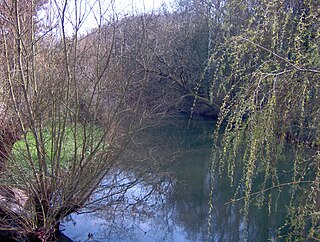 W
WThe River Avon is an English river in the south west of the country. To distinguish it from a number of other rivers of the same name, this river is often also known as the Bristol Avon. The name ‘Avon’ is a cognate of the Welsh word afon, ‘river’.
 W
WThe River Boyd is a river of some 7 miles (11 km) in length which rises near Dodington in South Gloucestershire, England. It is a tributary of the Bristol Avon, running in a southerly direction and joining near Bitton. The flow rate at Bitton is an average 19.8 cubic feet per second (0.56 m3/s). It was immortalised in the 1613 poem by John Dennys of Pucklechurch The Secrets of Angling, the earliest English poetical tract on fishing: And thou sweet Boyd that with thy watry sway Dost wash the cliffes of Deington and of Weeke And through their Rockes with crooked winding way Thy mother Avon runnest soft to seeke In whose fayre streames the speckled Trout doth play The Roche the Dace the Gudgin and the Bleeke Teach me the skill with slender Line and Hooke To take each Fish of River Pond and Brooke.
 W
WBrislington Brook is a short, 5 miles (8.0 km) long tributary of the Bristol Avon, rising on the northern slopes of Maes Knoll on the southern boundary of the city of Bristol, England. The stream has been badly affected by pollution but improvements have been made in the latter part of the twentieth century, and some wildlife is supported. St Anne's Well near the northern end of the brook was a major pilgrimage site for Christians in the Middle Ages.
 W
WThe Frome, historically the Froom, is a river that rises in Dodington Park, South Gloucestershire, and flows south westerly through Bristol, joining the former course of the river Avon in Bristol's Floating Harbour. It is approximately 20 miles (32 km) long, and the mean flow at Frenchay is 60 cubic feet per second (1.7 m3/s). The name Frome is shared with several other rivers in South West England and means 'fair, fine, brisk’. The river is known locally in east Bristol as the Danny.
 W
WThe Hazel Brook, also known as the Hen, is a tributary of the River Trym in Bristol, England. It rises at Cribbs Causeway in South Gloucestershire. From there, its course takes it south, passing the western end of Filton Aerodrome on its left bank, through Brentry and Henbury before dropping through a steep limestone gorge in the Blaise Castle estate. It continues south through two lakes before joining the Trym at Coombe Dingle.
 W
WThe Malago is a tributary of the Bristol Avon in southwestern England, some 5 miles (8.0 km) long. The river rises in springs on the north side of Dundry Hill on the borders of Somerset and Bristol. The main tributary is the Pigeonhouse stream which also rises on Dundry. Much of the river has been culverted as it flows through built-up South Bristol.
 W
WThe New Cut is an artificial waterway which was constructed between 1804 and 1809 to divert the tidal river Avon through south and east Bristol, England. This was part of the process of constructing Bristol's Floating Harbour, under the supervision of engineer William Jessop. The cut runs from Totterdown Basin at the eastern end of St Phillip's Marsh, near Temple Meads, to the Underfall sluices at Rownham in Hotwells and rejoining the original course of the tidal Avon.
 W
WThe River Severn, at 220 miles (354 km) long, is the longest river in Great Britain. It is also the river with the most voluminous flow of water by far in all of England and Wales, discharging an average of 107 m3/s (3,800 cu ft/s) into the Bristol Channel at Apperley, Gloucestershire. It rises in the Cambrian Mountains in mid Wales, at an altitude of 2,001 feet (610 m), on the Plynlimon massif, which lies close to the Ceredigion/Powys border near Llanidloes. The river then flows through Shropshire, Worcestershire and Gloucestershire. The three county towns of Shrewsbury, Worcester and Gloucester lie on its course.
 W
WSiston Brook rises in two separate streams which issue from a ridge just north of the village of Siston, South Gloucestershire, England. The brook is approximately 6 miles (9.7 km) long and is a tributary of the Bristol Avon. Much of its course is through the eastern suburbs of Bristol, although it remains outside the city boundaries. Tributaries include the Warmley Brook and an unnamed tributary from Bridgeyate.
 W
WThe River Trym is a short river, some 4.5 miles (7.2 km) in length, which rises in Filton, South Gloucestershire, England. The upper reaches are culverted, some underground, through mostly urban landscapes, but once it emerges into the open it flows through a nature reserve and city parks before joining the tidal River Avon at Sea Mills. 18th-century water mills near the mouth gave the area its name.